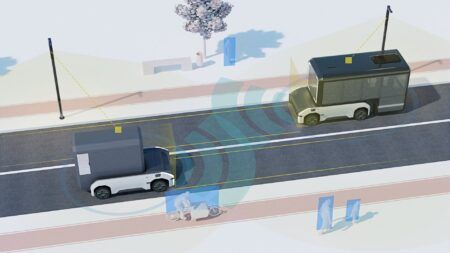A team led by the Southwest Research Institute (SwRI) has been awarded up to US$2.9m in funding to develop connected and automated vehicle (CAV) technologies that are aimed at improving fuel economy by more than 20%.
The US Department of Energy (DOE) investment will allow SwRI to build the algorithms and test them over the course of the three-year project. The project is paid for by the DOE, but is part of the Advanced Research Projects Agency’s (ARPA-E) Next-Generation Technologies for Connected and Autonomous On-Road Vehicles (NEXTCAR) program.
The three-year ‘Model Predictive Control for Energy-Efficient Maneuvering of Connected and Automated Vehicles’ project calls for the team to develop optimal control algorithms that make use of vehicle-to-vehicle (V2V), vehicle-to-infrastructure (V2I), and other vehicle-to- everything (V2X) technologies, to simultaneously optimize the vehicle’s route, speed profile, and power flows from the hybrid system.
In addition to SwRI, team members include Toyota Motor North America and the University of Michigan. These developments could help define future powertrain performance requirements and enable more efficient control of the powertrain and vehicle dynamics. SwRI will demonstrate these technologies using a Toyota 2017 Prius Prime plug-in hybrid electric vehicle (PHEV).
The team will develop and integrate components that assist in automated eco-driving, informing the vehicle about approaching traffic signals, as well as preferred routes and optimal vehicle speed profiles. Given this connected ‘look ahead’ preview of conditions, SwRI engineers also will optimize powertrain operation to achieve its goal of 20% improvement in fuel economy.
Recent rapid advances in driver assistance technologies and the deployment of vehicles with increased levels of connectivity and automation have created multiple opportunities to improve the efficiency of future vehicle fleets beyond in new ways. ARPA-E’s NEXTCAR Program supports ‘enabling technologies that use connectivity and automation to co-optimize vehicle dynamic controls and powertrain operation, thereby reducing the energy consumption of light-, medium- and heavy-duty vehicles’. Vehicle dynamic and powertrain control technologies, implemented on a single vehicle basis, across a cohort of cooperating vehicles, or across the entire vehicle fleet, could significantly improve individual vehicle and, ultimately, fleet energy efficiency.
Whereas current powertrain control is reactive, with drivers and vehicle systems responding to events after they happen, powertrain control technologies developed under the NEXTCAR program will demonstrate the potential to be predictive and anticipatory. The ARPA-E program is among the first to consider energy in CAV applications, coordinating vehicle dynamic controls and powertrain operation to maximize vehicle efficiency under real-world driving conditions. The NEXTCAR program emphasizes applications for vehicles that are not yet fully automated under NHTSA/SAE levels 0-3, or not yet capable of operating without a human present to intervene in certain situations.
“This is an important research step in furthering the development of powertrains for connected and automated vehicles,” said Scott Hotz, an assistant director in SwRI’s Engine, Emissions and Vehicle Research Division. “Our team’s collective expertise in vehicle powertrain development and connected and automated vehicle technologies will help optimize vehicle efficiency.”




